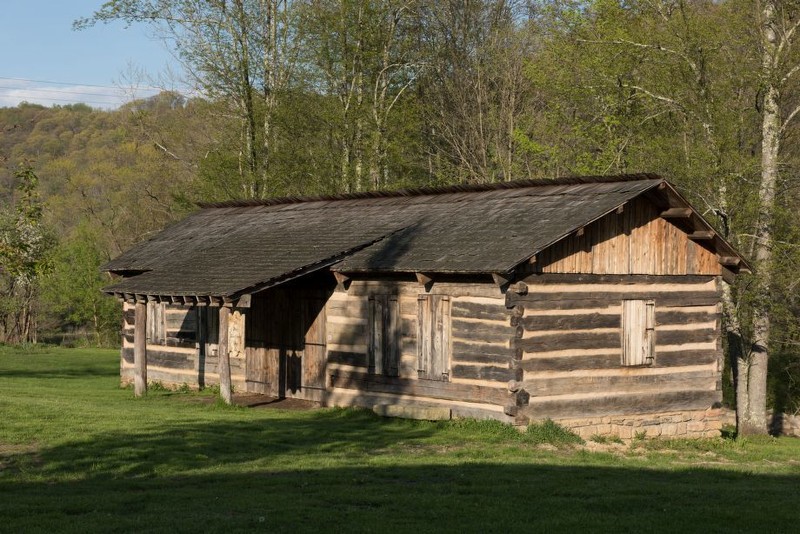Bray Blacksmith Shop
Introduction
Text-to-speech Audio
The Bray Blacksmith Shop gives visitors an up-close look at Blacksmithing skills, tools, and processes. Blacksmithing was an essential trade in the American colonies. On the western Virginia frontier, Blacksmithing provided important tools and materials for agriculture and home construction. The shop at Pricketts Fort is named for Greg Bray, the current executive director of the Pricketts Fort Memorial Foundation, who has been involved with the organization since the fort’s reconstruction.
Images
The Bray Blacksmith Shop allows Pricketts Fort to interpret an essential trade of the late 18th century. It was built using historic logs.

Backstory and Context
Text-to-speech Audio
Blacksmithing involves forging metals, particularly wrought iron or steel, using heat and tools that hammer, bend, and shape. This trade dates back to at least 1350 B.C., likely invented by the Hittites of Anatolia. The trade spread to ancient Greece and eventually throughout Europe and Central and South America, ushering in the Iron Age. Iron was notable for its strength and adaptability, allowing Blacksmiths to create more robust farming tools that improved agricultural productivity. European settlers brought the trade to the American colonies in the 17th century. Among the first settlers of Virginia in 1607 was a Blacksmith, and the Virginia Company soon recruited Blacksmiths and other craftsmen to relocate to the colony in order to ensure its success.
Blacksmiths created a wide range of tools essential to daily life in the American colonies. In his research on Blacksmithing in colonial Virginia, historian Harold B. Gill, Jr., wrote, “The Blacksmith's trade has been said to be the foundation of all other crafts…The art of the smith is essential to everyone who uses tools.” Blacksmiths created elements of farm equipment, kitchen implements, firearms, parts for machinery, and building materials for homes, barns, mills, and ships. Blacksmiths also created the tools they used in their own shops, including anvils, hammers, tongs, chisels, files, and vises.
The Blacksmith shop at Prickett’s Fort demonstrates the importance of this trade on the West Virginia frontier. Small communities like those around Prickett’s Fort would have had a Blacksmith to create and repair items for farms and homes. Farms needed, such as plow tips, blades, horseshoes, gates, and parts for wagons. Many Blacksmith products were found in the home, including nails, door handles and hinges, fireplace cranes, pots, skillets, candle holders, and light fixtures,
At its core, Blacksmithing requires a tool to pound the metal (usually a hammer), something to hit the metal against (usually a metal anvil), and an extremely hot fire. A typical Blacksmith forge consisted of a raised brick hearth with bellows that funneled air under the fire. Blacksmiths created fires with charcoal or coke, a flammable carbon product created by burning coal at high temperatures without oxygen. These hot fuels powered by bursts of air from the bellows made raised the forge’s temperature up to 2000-3000 °F (1000-1600 °C), hot enough to make the metal soft and pliable. Blacksmiths could then bend, lengthen, shape, weld, and punch holes in the metal to create the desired shape. This was a long process that involved a constant close watch on the temperature of the fire and metal, heating and cooling the metal as needed. Blacksmithing is a historically practical trade, but also a skilled art form. Blacksmiths often incorporated design elements into their work to show their abilities and personal style.
The Bray Blacksmith Shop was built by the Pricketts Fort Memorial Foundation using historic logs from a deconstructed house on the land of the Benedum Airport. Greg Bray, the current executive director of the Foundation and a Blacksmith himself, helped with the shop’s construction. Local companies donated equipment such as trucks and cranes to move and assemble the logs. The completed Blacksmith shop is 52 x 18 feet, a sizable structure that can house multiple workstations. It is used to demonstrate the work of Blacksmiths and interpret the history of Blacksmithing from the time of Pricketts Fort.
Sources
Bray, Greg. Images of America: Pricketts Fort. Charleston, SC. Arcadia Publishing, 2014.
Gill, Harrold B. The Blacksmith in Colonial Virginia, Colonial Williamsburg Foundation Library Research Report Series - 0022, Colonial Williamsburg Foundation Library. October 1965. Accessed May 31st 2022. https://research.colonialwilliamsburg.org/DigitalLibrary/view/index.cfm?doc=ResearchReports%5CRR0022.xml&highlight=.
"The History of Blacksmithing." Forge Magazine. March 17, 2017. Accessed May 31st 2022. https://www.forgemag.com/articles/84597-the-history-of-Blacksmithing
Highsmith, Carol M, photographer. Blacksmith shop outside the reconstructed fort at Prickett's Fort State Park, a 22-acre West Virginia state park north of Fairmont, near the confluence of Prickett's Creek and the Monongahela River. United States Marion County West Virginia, 2015. -05-02. Photograph. https://www.loc.gov/item/2015631600/.
